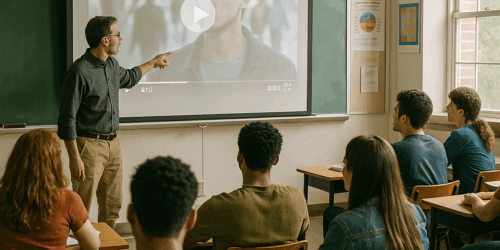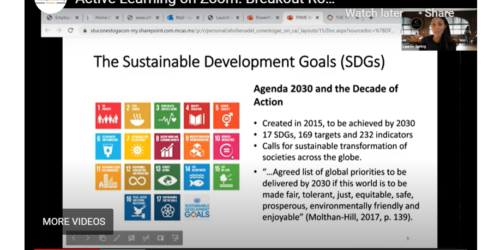
Jigsaw
What is it?
Students form groups in order to develop “expert” knowledge of one aspect of the lesson topic. The groups are then reconfigured so that an expert from each group explains what they have learned to the others in the new group. For example, each group is assigned a key concept from a reading. They together decide the best way to explain the key concept, and then they move into new groups where each explains their key concept while the others take notes and ask questions. Or each group can solve a math or other problem and then demonstrate in a new group how they did it.
Uses
- Promotes participatory learning either as a cooperative presentation of new learning (presentation phase of a lesson) or as an opportunity to practice what has been presented.
- Allows students to discuss course concepts or problem-solve together.
- Helps to build community and develop supports for learning.
- Can include choice of topic for a more motivating experience.
- Can be adapted for effective use across disciplines, including STEM, Business, Health, Interdisciplinary Studies, and language learning (e.g. Calkins & Rivnay, 2022; Sa’adiah et al., 2021; Shakerian & Hassan Abadi, 2020).
Process

- Do your math first. How many topics are there? That is the number of groups you want in the first round. How many people were there in the first groups? That is how many groups you want in the second round so that you can have one person from each group participate in a second group.
- Decide exactly what you want the first group to do. Should they take notes in a shared document? Draw a graphic to demonstrate what they are learning? How much time should they prepare to take to explain their point? Prepare your instructions carefully to avoid confusion.
- Decide exactly what you want the second group to do. Will you create a template for them to fill out with information as they learn from each expert? Will each take their own notes, or create a shared document?
- Be prepared to debrief at the end of the activity. If there is no input from you on the results, students may feel unsure whether their information is correct or their conclusions are valid.
Variations
Half Jigsaw
- Go through the first two steps described above.
- Instead of dividing students into new groups, have each group of experts explain their part to the whole class.
- Debrief after each explanation or at the end of the jigsaw so that the class achieves a sense of closure and confidence that the conclusions they have reached are valid.
Adapting to Different Modes
| Delivery Mode | Adaptations |
|---|---|
| In-Person | Provide a text to read or a topic for the “expert” group to research. Use the whiteboard or chart paper to spread student groups out spatially and to provide a visual tool for the explanation phase of the lesson. Have students in the first group number themselves off at the end of the first group activity. Have all the number 1’s go to group 1, in one corner of the classroom. Have all the number 2’s go to group 2, etc. |
| Synchronous Online | Follow a similar procedure to the in-person method, but use breakout rooms instead. Use a OneDrive document for the expert groups to create their information/presentation. |
| Asynchronous Online | Make instructions available through eConestoga. Create a group discussion forum for each expert group. Provide a shared OneDrive document, Padlet, wiki, or video platform for each expert group to create information for sharing. |
Considerations
- Keep the group sizes limited to only 4 to 6 to ensure everyone is participating.
- Give the instructions one step at a time. Jigsaw can have a complex procedure, so giving all the instructions at once can be confusing for learners.
- Draw a picture of what students are about to do in terms of forming groups on the whiteboard or on a PowerPoint slide.
- Check in with each group at least once to ensure that they know what to do and that they are on task. A shared collaborative document is useful for you to keep track of student progress.
- Be careful in where and when you apply this strategy. using this activity appropriately will lead to high order thinking skills and deeper learning. Overuse will lead to student complaints that the teacher is not doing their job.
References
Barkley, E. F., & Major, C. H. (2014). Learning assessment techniques: A handbook for college faculty. 2nd ed. Jossey-Bass, a Wiley brand.
Calkins, S. & Rivnay, J. (2022). The jigsaw design challenge. Journal of Effective Teaching in Higher Education, 4(3). https://doi-org.conestoga.idm.oclc.org/10.36021/jethe.v4i3.249
Persellin, D. C., & Daniels, M. B. (2014). A concise guide to improving student learning : Six evidence-based principles and how to apply them. Stylus Publishing.
Sa’adiah, H., Syaiful, S., Hariyadi, B. & Yudistira, P. (2021). Student team achievement divisions (STAD) and jigsaw learning in terms of numerical abilities: The effect on students’ mathematics learning outcomes. Desimal, 4(3), 247–260. https://doi-org.conestoga.idm.oclc.org/10.24042/djm.v4i3.9746
Shakerian, S. & Hassan Abadi, L.. (2020). Effect of the jigsaw technique as a cooperative learning approach on motivation and job performance of community health workers: A quasi-experimental study. Journal of Education and Health Promotion, 9(1), 274. https://doi-org.conestoga.idm.oclc.org/10.4103/jehp.jehp_176_20







2 Responses